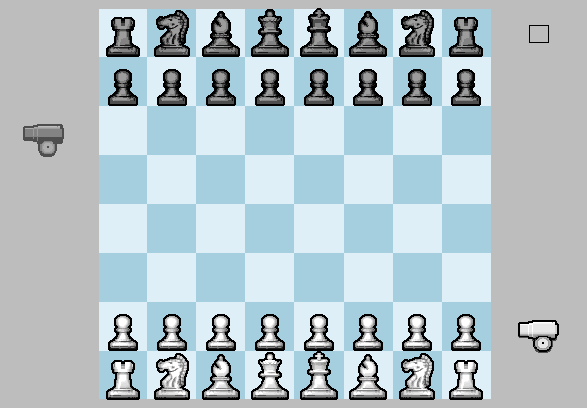

In Stahlberg Chess the rules are the same as in orthodox chess, except that one or two extra pieces per player are placed in the reserve. Before starting, the players must decide whether they want to use the extra pieces. To make a decision, press on the little black square. Only if both players choose not to use the extra pieces, then it becomes a regular game of chess. If white turns down the extra pieces, then black can overrule this.
If players have elected to include external pieces, they may either move a piece or pawn, or drop an extra piece from the reserve. Pieces may only be dropped on a friendly pawn on the second rank. The removed friendly pawn must immediately be relocated two squares ahead of the dropped piece. This position, and the position in between, must be empty. If not, the piece cannot be dropped on the friendly pawn. Should a player refrain from inserting his extra pieces at these occasions, then he has forfeited his chance of introducing them. Note that pieces and pawns are allowed to move before an extra piece has been dropped. You are allowed to make a pawn-relocation if in check, if the pawn-relocation covers the check. The relocated pawn can be captured by 'en passant'.
Stahlberg Chess is normally only played with one extra piece each, namely the Swedish Cannon: after having jumped any piece, the Swedish cannon can slide and capture like a rook. However, if no jump move exists it's allowable to slide like a rook, but without capturing. The Swedish Cannon has about the same value as a bishop. The closest relative of the Swedish Cannon is the Korean Cannon. A second piece can optionally be used. This is the Chancellor (Princess): combines the powers of a Rook and a Knight. It is comparable in strength to the queen. The Swedish Cannon derives from Swedish Cannon Chess. The Chancellor was known already in the 17th century. D. Pietro Carrera used this piece in his variant Carrera's Chess. He wrote a long book on chess, called 'Il Gioco delgi Scacchi', and published it in 1617 in Miltello in Sicily.
In Stahlberg Chess standard chess is included as an option, thereby maintaining the historical connection. In a tournament, by way of the initial voting procedure, players can decide to play a traditional game. Introducing the external pieces implies a weakening of the pawn chain, so it's a difficult strategical question whether one should wait, or immediately make use of the drop move to advance a centre pawn two steps. But dropping an extra piece on the king- or queen pawn could block the development of the bishop. Waiting has its obvious advantages, although the alternative positions where the piece can be dropped will become fewer and fewer.
The Swedish Cannon can take active part early in the game, so one ought to introduce it early. The Cannon can be exchanged for a light piece that has acquired a good position, or it can threaten an enemy rook on an half-open file. The Swedish Cannon is stronger than both its counterparts, the Korean Cannon and Chinese Cannon, making it easier to introduce it in a context of Western pieces. Its movement is similar to the Korean Cannon, but the Korean Cannon is stranded when no jump moves are available. This cannot befall the Swedish Cannon while it is then, and only then, allowed to slide like a rook, but without capture. Interestingly, if the enemy Cannon has no jumps, then one can sometimes position a piece so as to provide a jumping option, thus preventing the Cannon from using his right to move like a rook. Stahlberg Chess was invented and implemented by undersigned, May 2007.
 Gideon Ståhlberg. Stahlberg Chess was created in remembrance of Swedish grandmaster Gideon Ståhlberg (1908-67), Sweden's first official grandmaster. Ståhlberg became Scandinavian Champion in 1929. His rating for the year 1949 has afterwards been calculated to 2750, and he was the third strongest player in the world in that year. Ståhlberg umpired in the 1963 Botvinnik - Petrosian World Championship match. He wrote several quality chess books, and co-authored a book with Golombek: Chess and Chess Masters: The Greatest Players of the Mid-20th Century. His style of play is reminiscent of J.R. Capablanca and Akiba Rubinstein. The attached game is Stahlberg - Golombek, Amsterdam 1950.
Gideon Ståhlberg. Stahlberg Chess was created in remembrance of Swedish grandmaster Gideon Ståhlberg (1908-67), Sweden's first official grandmaster. Ståhlberg became Scandinavian Champion in 1929. His rating for the year 1949 has afterwards been calculated to 2750, and he was the third strongest player in the world in that year. Ståhlberg umpired in the 1963 Botvinnik - Petrosian World Championship match. He wrote several quality chess books, and co-authored a book with Golombek: Chess and Chess Masters: The Greatest Players of the Mid-20th Century. His style of play is reminiscent of J.R. Capablanca and Akiba Rubinstein. The attached game is Stahlberg - Golombek, Amsterdam 1950.
• You can download my free Ståhlberg Chess program here (updated 2009-10-21), but you must own the software Zillions of Games to be able to run it (I recommend the download version).
• Don't miss my other chess variants.
© M. Winther (May 2007).